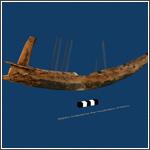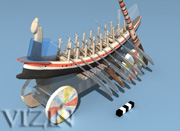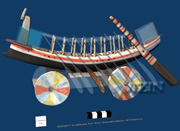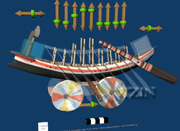Gurob Egypt |
All the Angles
We began by examining the high-resolution photographs, drawings, and detailed descriptions and dimensions of the excavated pieces provided to us by Wachsmann. These data formed the basis for the as-found 3D model of the ancient ship. From the basic as-found model, we could output the files for viewing with virtual reality (VR) software and allow Wachsmann (and colleagues) to examine the ship as though holding a single object in their hands. The VR version allowed nuances of the object to be examined close-up, it could be rotated it in any direction, and the ship could be viewed from all angles to compare against photos, providing an exciting and effective way to study ancient objects. click to load the virtual reality model of the completed as-found ship, with as many of the extant pieces assembled as possible to show the main features of the ship itself; © 2007 Institute for the Visualization of History, Inc.
click to load the virtual reality model of the completed as-found ship, with as many of the extant pieces assembled as possible to show the main features of the ship itself; © 2007 Institute for the Visualization of History, Inc.
Next, we worked on the form and colors of the little wooden model as originally carved using what we had learned about the various features from building the virtual as-excavated version. Wachsmann’s research into ancient ships of the period helped fill the gaps and provided plausible evidence for various details. We first modeled the basic vessel and then began testing how the remaining loose pieces (such as the stanchions, quarter rudder, and oars) might have fit into the original design.
Additional programming on top of the VR model provided Wachsmann with moveable virtual parts so he could see how changing their positions might affect the look of the ship. Different iterations could be compared to the varying ancient depictions to see which configuration most closely matched a majority of representations. Some features of the ship (such as the angle of the steering oar) could be more definitively aligned based on traces of surviving paint, which seemed to indicate how those pieces were originally attached.
After we had a good working model of the as-built original, we could add elements that would have most likely been part of the original design, but that did not survive. Clues found on the existing pieces suggested possible locations for these missing elements. Remnants of paint along the hull allowed us to complete the oar ports and black paint on the lower portion of the hull. We chose a translucent neutral toned shade to indicate the hypothetical areas for which there are no surviving fragments.
The last items we tested were the wheels, the so-called “awnings,” and other miscellaneous pieces not already positioned. We tried different locations for the wheels, close together and farther apart. It became immediately clear that the location and angle of the quarter rudder determined where the wheels could be positioned, and that the “awnings” could not be used as fenders as they would interfere with the quarter rudder. These details would have most likely gone undetected without testing the all the various options via real-time computer graphics. Also, we discovered, through experimenting with wheel placement, that the wheels have slightly different diameters. They could not be placed randomly, as certain arrangements caused the ship model to tip oddly. This peculiarity was discovered only upon rotating the model in virtual reality and inspecting it from various viewpoints. The differences in the wheels’ sizes were not appreciated until that point, but clearly reflect where each wheel was originally placed.
None of these issues or their eventual resolutions would have become evident working only with the pieces individually or by drawing their presumed configurations. Thus, working through the reconstruction process using interactive 3D computer models demonstrated that many aspects of the original design could not have been fully appreciated through traditional analytical methods or simply by eye alone. Despite the small size of the Gurob ship model, the use of interactive 3D computer graphics technologies provided Wachsmann with new insights and new opportunities for understanding and investigating the object and its many pieces.
When the paper publication of the ship-cart was published (See Wachsmann's entry: Research Resources page) the Institute simultaneously published a digital supplement that includes all the interactive models, links to a large catalogue of high-resolution images, and more.
Reference
Page Created: March 13, 2012
Page Updated: July 6, 2013
URL:
Page Author: The Institute for the Visualization of History


